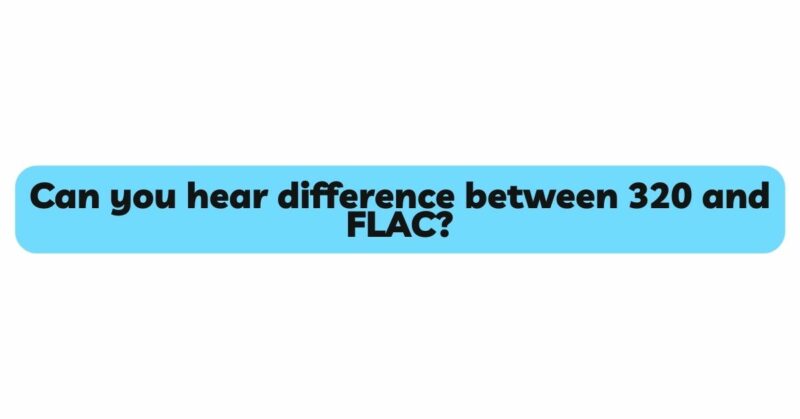In the realm of digital audio, discussions surrounding audio quality are as vibrant as the melodies they seek to capture. Among the debates, a notable question arises: Can you hear the difference between 320kbps and FLAC? This inquiry lies at the crossroads of audio fidelity and technological advancement, captivating audiophiles, music enthusiasts, and researchers alike. This article delves into the intricacies of audio compression, the complexities of human auditory perception, scientific experiments, and the implications of distinguishing between these two formats.
Deciphering Audio Compression and Formats
Before embarking on the journey of discerning differences, it’s crucial to decode the essence of 320kbps and FLAC:
- 320kbps: Representing the bit rate, 320kbps stands for kilobits per second. It is a high-quality audio compression format, often associated with MP3 files. The compression removes audio data deemed less crucial to human hearing, resulting in smaller file sizes.
- FLAC (Free Lossless Audio Codec): FLAC is a lossless audio compression format designed to preserve the original audio fidelity while reducing file size. Unlike lossy formats like MP3, FLAC retains all audio data, ensuring an exact reproduction of the original source.
The Complex Landscape of Auditory Perception
To unravel the nuances of discerning between 320kbps and FLAC, one must delve into the intricate realm of human auditory perception.
Influencing Factors in Auditory Perception
Several factors contribute to an individual’s ability to detect differences between 320kbps and FLAC:
- Listening Environment: The acoustic characteristics of the listening space, background noise, and room treatment significantly influence how sound is perceived.
- Playback Equipment: The quality of headphones, speakers, amplifiers, and digital-to-analog converters (DACs) play a pivotal role in faithfully reproducing the intricacies present in both 320kbps and FLAC formats.
- Individual Hearing Sensitivity: Audiophiles and those with trained ears may exhibit heightened sensitivity, enabling them to detect subtle sonic nuances.
Scientific Exploration: Listening Tests
The pursuit of objectively determining if listeners can indeed hear the difference between 320kbps and FLAC has given rise to scientific experiments. Double-blind listening tests, where neither the listener nor the experimenter knows the audio source, serve as a crucial methodology for evaluating perceptual distinctions.
Varied Findings in Research
The findings from these listening tests are diverse, presenting a mosaic of outcomes. Certain studies suggest that listeners, particularly those attuned to audio intricacies, can perceive differences between 320kbps and FLAC under controlled conditions. These distinctions might be more pronounced when the quality gap between the two formats is substantial. Conversely, other research contends that the perceptual variances might not be as prominent in real-world listening environments.
The Role of Psychoacoustics
The domain of psychoacoustics, which studies how humans perceive sound, introduces an additional layer of complexity to deciphering differences between 320kbps and FLAC. Masking effects, where louder sounds conceal quieter ones, influence our perception of certain frequencies. Furthermore, the brain’s propensity to “fill in the gaps” in auditory information further shapes our perception.
Subjective Perception and Expectation Bias
Subjective perception adds a psychological dimension to the exploration of differences between 320kbps and FLAC. The phenomenon of expectation bias, where preconceived beliefs influence perception, can sway listeners’ assessments. If participants expect to hear an improvement due to the FLAC format’s reputation, their predisposition might lead them to perceive differences, irrespective of their objective presence.
Real-World Significance and Musical Context
The inquiry into whether one can hear a difference between 320kbps and FLAC extends beyond theoretical curiosity:
- Music Production: FLAC is favored in music production and mastering studios for capturing intricate sonic details without compromising audio quality.
- Audiophile Enthusiasts: Audiophiles, equipped with precise equipment and an affinity for sonic excellence, may cherish the enhanced dimensions that FLAC offers.
- Everyday Listening: For the average listener, the perceptible differences between 320kbps and FLAC might be nuanced. Everyday listening conditions and common playback devices might not fully capitalize on the potential improvements.
Conclusion: The Melody of Perception
The exploration of differences between 320kbps and FLAC intertwines technology, auditory perception, and individual preferences. While scientific experiments provide insights into the potential for perceiving distinctions, their real-world implications are a symphony of variables, including auditory conditions, hearing acuity, and playback equipment.
The appreciation of audio quality extends beyond empirical analysis; it harmonizes technological evolution, artistic creation, and the emotional connections listeners forge with music. The question of whether one can hear a difference resonates as a symphony of individual perception, psychological influences, and the ceaseless exploration of auditory landscapes.


